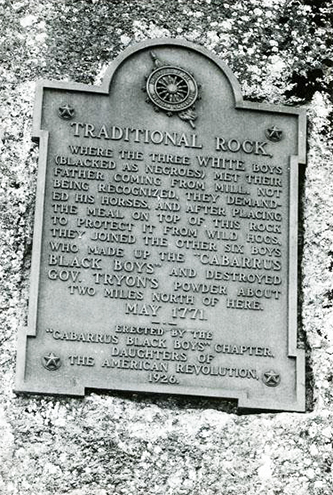Cabarrus Black Boys
 The Cabarrus Black Boys were nine young men from Rowan and Mecklenburg (later Cabarrus) Counties who took part in an infamous raid against a royal governmental military convoy during the Regulator Movement in North Carolina in the years before the American Revolution. On 9 May 1771 Gen. Hugh Waddell left Salisbury en route to Hillsborough to assist Governor William Tryon in quelling the Regulator uprising. After crossing the Yadkin River, Waddell's militia encountered a numerically superior body of Regulators and began to fall back to Salisbury. A small band of Regulators, disguised as Indians, attacked a convoy that was carrying gunpowder from South Carolina to Waddell. The group burned two powder wagons as well as destroyed some blankets, leggings, kettles, and other supplies.
The Cabarrus Black Boys were nine young men from Rowan and Mecklenburg (later Cabarrus) Counties who took part in an infamous raid against a royal governmental military convoy during the Regulator Movement in North Carolina in the years before the American Revolution. On 9 May 1771 Gen. Hugh Waddell left Salisbury en route to Hillsborough to assist Governor William Tryon in quelling the Regulator uprising. After crossing the Yadkin River, Waddell's militia encountered a numerically superior body of Regulators and began to fall back to Salisbury. A small band of Regulators, disguised as Indians, attacked a convoy that was carrying gunpowder from South Carolina to Waddell. The group burned two powder wagons as well as destroyed some blankets, leggings, kettles, and other supplies.
The men involved in this episode were either blackened by their Indian disguises or by the powder as they emptied it from kegs, and the name "Black Boys of Cabarrus" was applied to them at a later time. By a proclamation of 11 June 1771, Tryon offered amnesty to certain categories of Regulators, but this did not apply to those who were involved in blowing up Waddell's gunpowder. James Ashmore, who lived near the site, swore under oath that the Cabarrus Black Boys, in addition to himself, were Robert Caruthers, Benjamin Cockran, Robert Davis, Joshua Hadley, James White Jr., John White Jr., William White, and another William White, identified as the "son of the Widow White."
Reference:
William S. Powell, James K. Huhta, and Thomas J. Farnham, eds., The Regulators in North Carolina: A Documentary History, 1759-1776 (1971).
Additional Resources:
Barefoot, Daniel W. "The Southern Piedmont Tour." Touring North Carolina's Revolutionary War Sites. Winston-Salem, N.C.: John F. Blair. 1998. p. 162-163. http://books.google.com/books?id=g9PTESIlqwoC&printsec=frontcover#v=onepage&q&f=false (accessed October 31, 2012).
Kent, Scotti. It Happened in North Carolina. Guilford, Conn.: Globe Pequot. 2000. p.16. http://books.google.com/books?id=tKHq25ssqQkC&lpg=PP1&pg=PA16#v=onepage&q&f=false (accessed October 31, 2012).
Image Credits:
"Photograph, Accession #: H.19XX.424.8." 1926-1930. North Carolina Museum of History.
1 January 2006 | Powell, William S.